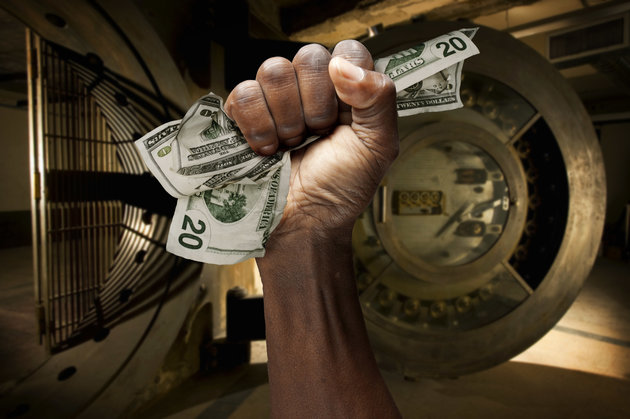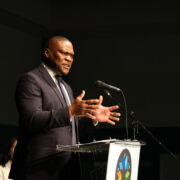
Martin Luther King Jr. made a radical economic call to action in his final speech.
Stop supporting white-owned businesses until they make fair treatment of black people a priority, he said in his April 3, 1968 “I’ve Been to the Mountaintop” speech in Memphis. He urged black citizens to start moving their money from white-owned banks to a local, black-owned bank.
“[W]e’ve got to strengthen black institutions. I call upon you to take your money out of the banks downtown and deposit your money in Tri-State Bank. We want a ‘bank-in’ movement in Memphis,” he said.
King’s request went unanswered.
In fact, since then, black-owned banks have been on a steady decline. Dozens have either closed or been sold since the 1990s. There are currently 20 banks that are primarily black-owned in America. Unlike most major banks, individually, none of them have attained a billion dollars in assets.
Now, one group is challenging black Americans to help sustain their own. Justin Moore, Stephone Coward and Robert Herring III are the leaders behind Bank Black USA, a platform that encourages people to support black-owned banks.
Through Bank Black USA, the group is calling on Americans to deposit $500 million into black-owned banks by next Martin Luther King Jr. Day, January 15, 2018.
Moore told The Huffington Post that his group’s initiative stemmed from the #BankBlack movement that rapper Killer Mike championed in summer 2016 in response to police brutality. Many people, including Solange Knowles, opened bank accounts with black-owned banks. This eventually led to $50 million moved into black banks within a six-month span, according to the FDIC.
Moore thinks black Americans can multiply that effort ten-fold within a year. His organization believes that if they equip people with more information than just a list of black-owned banks, people will be more apt to use their services longterm.
Bank Black USA currently uses a Google spreadsheet to show data for 15 black- owned or -operated banks and credit unions, eight of which allows customers to open accounts online. In addition to interest rates and fees for accounts, it also shows grades for services like ATM access and online and mobile usability based on informal feedback from customers. The chart also includes government- and National Community Investment Fund- issued grades that indicate what these banks are doing with their money, how they’re governed and the overall health of each bank.
We’ve been seeing these institutions disappear from our communities and these are the institutions that understand black communities and, equally, low income communities.Justin Moore, Bank Black USA organizer
Moore said this information is important because people can see who much these banks invest in black communities.
“We’ve been seeing these institutions disappear from our communities and these are the institutions that understand black communities and, equally, low income communities,” Moore said. “And banking is a relationship as much as it is a number. Deciding whether or not to lend you money for a house, there’s an equation for that but there’s also discretion to that. That there’s a human being somewhere… [making] a choice whether or not there’s gonna be that access of financial services to people. And that’s something that there’s a lot of importance in the role these institutions play.”
Discrimination in financial institutions is real and affects many black people. In January, the U.S. Justice Department accused KleinBank of redlining for failing to make its services available in areas dominated by people of color in Minneapolis and St. Paul. A few days later, JPMorgan Chase paid a $53 million settlement over the bank’s brokers allegedly charging higher interest rates to minority borrowers than white borrowers. Just last year, BancorpSouth, a regional Mississippi bank, had to pay a $10.6 million settlement over allegations of discriminatory mortgage lending practices.
Black-owned banks are significantly more likely to lend in low-to-moderate income communities and to borrowers of color than many major banks. Sixty-seven percent of home loans made to black borrowers in 2011 came from black-owned banks in comparison to less than one percent for other community banks, a 2014 FDIC Minority Depository Institutions study found.
These unjust banking practices are more than a century old. This is partly why OneUnited’s president and owner, Teri Williams, calls the #BankBlack movement “an extension of the Civil Rights movement.”
“The black community spends $1.2 trillion a year and 98 percent of that funding happens outside of our communities, leaving our community with very few resources to build wealth.”Teri Williams, President of OneUnited Bank
“[W]e want people to not only move their money but to move their mind or in essence, change their mindset to one of trying to figure out ways to do more business with black-owned businesses,” Williams told HuffPost. “The black community spends $1.2 trillion a year and 98 percent of that funding happens outside of our communities, leaving our community with very few resources to build wealth.”
With more than $640 million in assets, OneUnited is the largest black-owned bank in the country. Other banks, such as Liberty Bank, Citizens Trust and Industrial Bank are also doing relatively well. But banks like the formerly black-owned Seaway, which was just sold to an Indian-American family in January despite earning $8 million in deposits from the #BankBlack movement, might need more than a hashtag or campaign.
The issues black banks face are reflective of larger issues plaguing other areas of black life. Inadequate access to housing, healthcare and education are just a few examples.
Moore believes that supporting these banks can help alleviate some issues black communities face.
Many black-owned banks are located in what Moore calls “bank deserts,” communities that need access to financial services. These banks are more likely to use their customers’ money to serve communities of color (i.e. OneUnited Bank’s recent partnership with Black Lives Matter), an less likely to fund projects that harm communities of color (i.e. major banks funding the Dakota Access pipeline.)
“The majority of [black-owned banks’] services are going to communities of color and that has a big impact cause that means people don’t have to go to the payday loan place,” Moore said. “You taking your $500, $5,000, $50,000 out is not gonna hurt Chase bank, but you putting your $500, $5,000, $50,000 into X black-owned bank that is turning around and doing things with that money that affect people in your community directly or your people nationally in communities like yours is very tangible.”
Williams said visibility is one of her banks biggest challenges. People need to know the bank exists. She said this is especially important for all black banks now because of the new White House administration.
“We are concerned about the communities that we serve,” she said. “We see what’s happening in terms of people being able to qualify for home loans and build wealth… Things have improved from the worst of the recession, and we were headed in the right direction, but we are concerned that there may be some setbacks going forward. We’re doing what we can to make sure that that doesn’t happen but that is our concern.”
Because of their investment in black communities, Moore stressed that it’s vital that “a critical mass” of black banks survive. Bank Black USA’s $500 million challenge may be a tall order for these institutions, but he said it’s feasible.
“The power and potential of black people, allies ― especially in the climate that we’re in now ― to help ensure that institutions that have over a long period of time lived through adversity, discrimination, difficult circumstances and are still doing the important work of serving their communities, investing in their communities,” he said. “It’s really important to continue that as much as we can and to hopefully grow it to a scale that is… strong enough to be the kind of anchor that we need when going through the changes and challenges that we have coming.”










